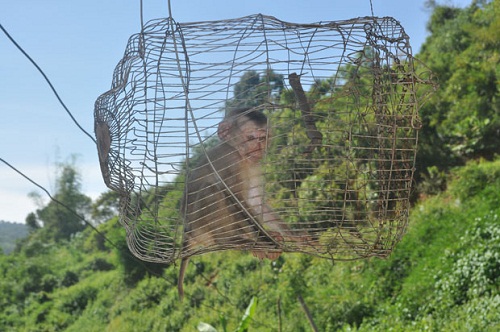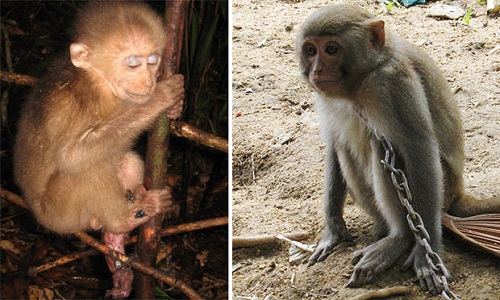Haunting photos of ill-fated monkeys
Mr Tran Huu Vy from Da Nang’s Cam Le District has to date posted 101 photos of ill-fated monkeys on his Facebook page. These animals were snatched from the wild, mercilessly trapped in forests, and illegally held in captivity.
The collection of photos, themed 'When could I be free from captivity?', have been taken by Mr Vy since 2006 in many localities nationwide, including Da Nang and the provinces of Gia Lai, Kon Tum, Ha Tinh and Quang Binh. These 5 localities are now home to 5 species of monkey: Macaca leonine, Macaca assamensis, Macaca assamensis, Macaca fascicularis and Macaca mulatta.
 |
| A trapped monkey |
The photos truly reflect the touching images of monkeys grieving for the loss of their freedom, as well as clearly expose the cruel ways in which these animals are captured and condemned to a life of misery.
During his research trip to Kon Tum Province’s Chu Mom Ray National Park in 2009, Mr Vy and his friends found a monkey which had been hung from a tree branch for about a week in the rain and high humidity. The hungry animal’s ankles smelt bad, and they were swollen and covered in a swarm of flies. He and his friends promptly rescued and released the monkey back into the forest.
 |
| Ill-fated monkeys are being trapped and chained |
On another journey to the province’s Bo Y International Border Gate, Mr Vy discovered an old red-faced macaque monkey which had been trapped in a snare before it was brought home by a local resident. Mr Vy enthusiastically taught the caregiver how to clean out the monkey’s wounds to prevent infection, and encouraged him to release the distressed monkey back into the wild. Mr Vy also reported the case to local forest rangers to deal with.
Mr Vy intends to set up a group of monkey lovers in the near future in order to exchange information about species of monkeys and biodiversity conservation activities. He added he hoped that the group’s members would become actively involved in raising public awareness about protecting these primates and other wild animals.